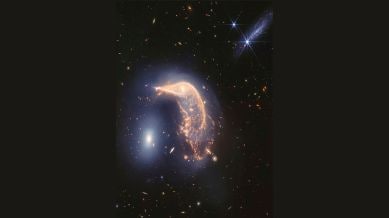NASA marks James Webb Space Telescope’s second anniversary with galaxy images
The Penguin and the Egg galaxies are together referred to as Arp 142.

NASA’s James Webb Space Telescope (JWST) celebrated its second science anniversary on July 12, 2024, with a stunning photo of two galaxies known as the Penguin (NGC 2936) and the Egg (NGC 2937). These galaxies are together referred to as Arp 142.
The galaxies were captured in near- and mid-infrared photos, situated about 326 million light-years far in the Hydra constellation.
The continuous interaction between these galaxies, which began 25–75 million years ago, was revealed by the JWST. This cosmic dance will persist for millions of years until the Penguin and the Egg merge into a single galaxy.
Bill Nelson, the administrator of NASA, said, “Since President Biden and Vice President Harris revealed the first image from the James Webb Space Telescope two years ago, Webb has consistently revealed the universe’s mysteries.”
Future scientists and explorers are inspired by the telescope’s complex capabilities. The director of NASA’s Astrophysics Division, Mark Clampin, highlighted how the James Webb Space Telescope (JWST) has revolutionized our knowledge of the cosmos.
JWST’s studies combine near- and mid-infrared light to show the interaction of the galaxies, revealing a mixture of stars and gas whirling between them.
The Penguin, which was once a spiral galaxy and now resembles an eye with outstretched arms that create a beak and tail. On the other hand, the elliptical galaxy Egg, which is packed with old stars, keeps its compact form, indicating that the mechanics of star creation in the Egg are different from those in the Penguin.
JWST, the Hubble Space Telescope’s replacement, can now see farther into the history of the cosmos because of its novel multiple mirror design, which increases light collection capabilities.